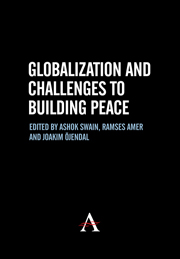Book contents
- Frontmatter
- Contents
- Acknowledgements
- List of Contributors
- 1 Building Peace in the Era of Three Waves
- 2 The Problem of Peace: Understanding the ‘Liberal Peace’
- 3 Pre-emptive Self-defence New Legal Principle or Political Action?
- 4 Beyond Criminal Justice: Promoting the Rule of Law in Post-Conflict Societies
- 5 Peace by Pact: Data on the Implementation of Peace Agreements
- 6 Refugee Repatriation as a Necessary Condition for Peace
- 7 Catapulting Conflicts or Propelling Peace: Diasporas and Civil Wars
- 8 UN Peace Operations as Norm Entrepreneurs: The Challenge of Achieving Communicative Action on Human Rights
- 9 To Practice What They Preach: International Transitional Administrations and the Paradox of Norm Promotion
- 10 Re-examining the Roots of War in West Africa in a Globalizing World
- 11 The African Union (AU) and Its Commitment to Non-Indifference: Can the AU be an Actor for the Promotion of Human Security?
- 12 Hamas Between Sharia Rule and Demo-Islam
- 13 Environmental Scarcity and Intrastate Conflicts: The Case of Nepal
- 14 Narcotics: The New Security Threat for China
- References
- Bibliography
13 - Environmental Scarcity and Intrastate Conflicts: The Case of Nepal
Published online by Cambridge University Press: 05 March 2012
- Frontmatter
- Contents
- Acknowledgements
- List of Contributors
- 1 Building Peace in the Era of Three Waves
- 2 The Problem of Peace: Understanding the ‘Liberal Peace’
- 3 Pre-emptive Self-defence New Legal Principle or Political Action?
- 4 Beyond Criminal Justice: Promoting the Rule of Law in Post-Conflict Societies
- 5 Peace by Pact: Data on the Implementation of Peace Agreements
- 6 Refugee Repatriation as a Necessary Condition for Peace
- 7 Catapulting Conflicts or Propelling Peace: Diasporas and Civil Wars
- 8 UN Peace Operations as Norm Entrepreneurs: The Challenge of Achieving Communicative Action on Human Rights
- 9 To Practice What They Preach: International Transitional Administrations and the Paradox of Norm Promotion
- 10 Re-examining the Roots of War in West Africa in a Globalizing World
- 11 The African Union (AU) and Its Commitment to Non-Indifference: Can the AU be an Actor for the Promotion of Human Security?
- 12 Hamas Between Sharia Rule and Demo-Islam
- 13 Environmental Scarcity and Intrastate Conflicts: The Case of Nepal
- 14 Narcotics: The New Security Threat for China
- References
- Bibliography
Summary
Introduction
Nepal is poised on the verge of a historic and precarious precipice. Nepal, having suffered from a more than decade long armed conflict with devastating impacts on the social and political foundations of the country, is on the verge of peace. Although in size, Nepal is only 855 km from east to west and 193 km from north to south, and populated by 24.2 million people, it is situated between India and China, having potentially large geopolitical and strategic impacts on world politics. Members of the Maoist insurgents are poised to become part of the mainstream political structure. Yet, if they were to be dissatisfied with the peace process and stage a coup for example, strong reactions would come from both of its neighbours. The way in which Nepal chooses to solve its conflict and address the primary and secondary causes of it, certainly has implications for leaders and international security policy experts with interests in countries with similar preconditions; they can potentially learn from the Nepali case, and avoid thousands of unneeded lost lives.
At the writing of this chapter, peace talks between the Maoist talk team and the Seven Party Alliance (SPA) were underway. Although the appointment in August 2006 of Mr Ian Martin, Personal Representative of the United Nations Secretary General in Nepal for Support to the Peace Process (a choice hailed by all parties to the conflict) the inability of the parties to advance on topics such as the role of the monarchy and the management of arms and armies, has led to untenable peace and a future with potential further violence.
- Type
- Chapter
- Information
- Globalization and Challenges to Building Peace , pp. 213 - 220Publisher: Anthem PressPrint publication year: 2007



